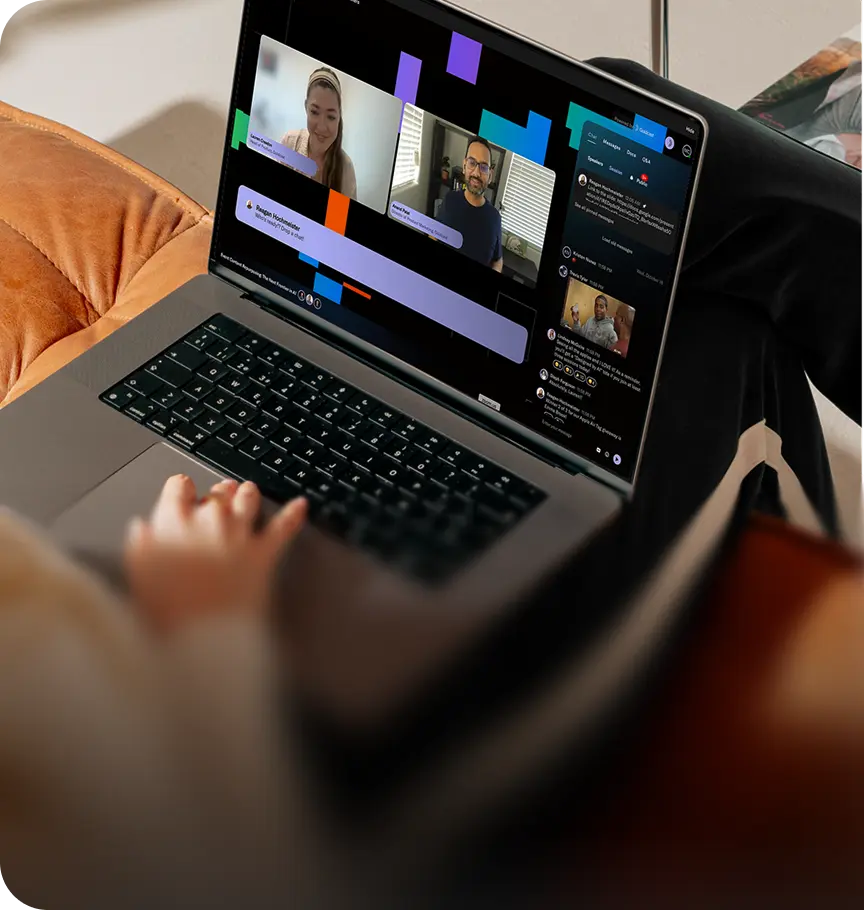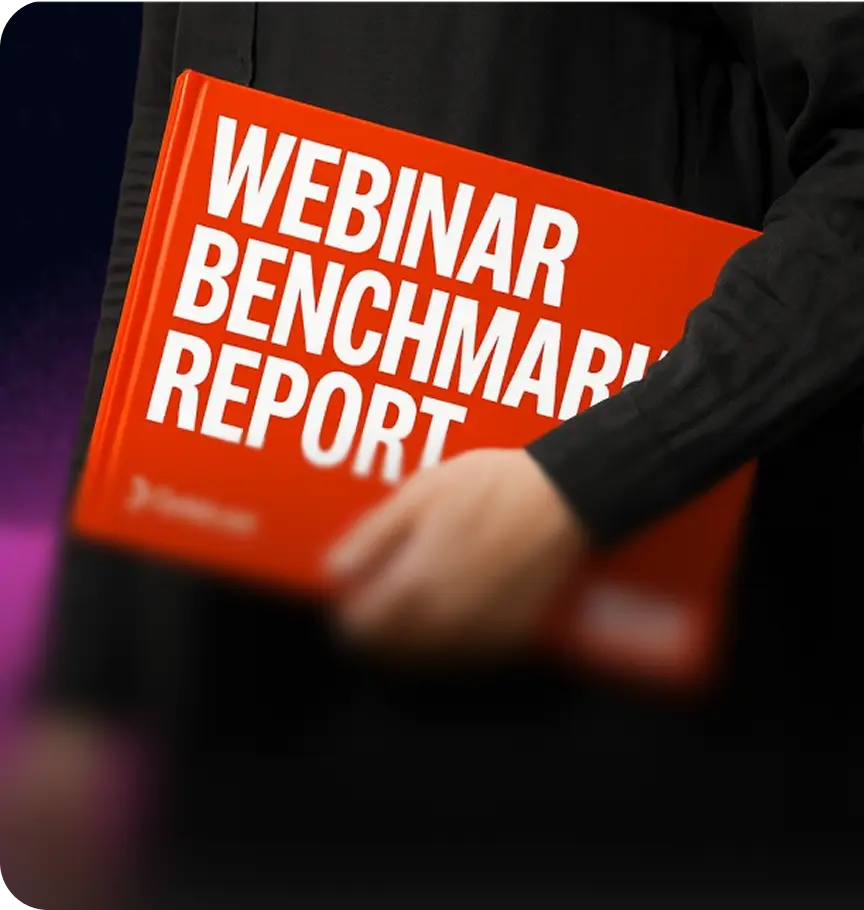The B2B Marketer’s Secret to Flawless Video, Every Time

Table of Contents
- What is local recording?
- Benefits of local recording for B2B brands
- Beyond better quality: How top B2B brands actually use local recording
- Challenges of local recording (and how to overcome them 💪)
- The future of content creation: All-in-one recording and amplification
- Stop settling for so-so content
Maximize Your Marketing ROI
Join 10,000 other marketers already getting the best tips on running engaging events that boost pipeline and create raving fans.
You've spent weeks organizing a high-stakes webinar. Your VIP speaker is ready to share game-changing insights. The audience is eager. And then... that dreaded moment hits.
Your speaker's video starts glitching, their audio cuts in and out, and your premium content suddenly looks more like an outdated video game than a professional B2B event.
Sound familiar? While technical hiccups are common headaches for B2B marketers, they're not inevitable. Local recording gives you studio-quality video, no matter how rocky the Wi-Fi.
Turn your video content into an always-on content engine.
What is local recording?
Local recording is exactly what it sounds like—high-quality video files and audio recordings directly on each participant's computer rather than recording the stream of data sent over the internet.
But why does this simple difference matter so much?
Local recording vs cloud recording
Think of cloud recording (what you get with standard Zoom meeting tools) like watching a YouTube video on bad Wi-Fi. It captures the video and audio as it's received over the internet. If the connection waivers, you get freezes.
Local recording, on the other hand, is like having a professional camera operator at each person's location. It captures pristine source files directly from each participant's machine, completely separate from any internet issues. This means you get the highest possible quality from everyone's camera and microphone, regardless of connection stability.
Of course, local recordings come with their own challenges. Large file sizes can quickly eat up storage space and make file sharing much more complicated.
Without proper management, locally recorded files can be vulnerable to hardware failures or device theft—a serious concern when dealing with compliance-sensitive content.
Modern tech has solved these headaches, but knowing the basics of local versus cloud recording is important for choosing tools that make your investment in video worth it.
Why does this matter for branded content?
In B2B marketing, every piece of content is a direct reflection of your brand.
With 97% of marketers now incorporating video into their strategies and 90% rating it as important to their content strategy, when prospects watch your webinars, virtual events, or video podcasts, they're not just judging the information—they're judging the experience.
Poor quality recordings can make even the most valuable insights feel amateur. Worse, technical issues can make it nearly impossible to repurpose your content. (Try turning a pixelated, glitchy recording into quality social media clips. 🫠)
If you want to build genuine authority—not to mention pipeline—your source material matters.
Local recording is the foundation for creating high-quality video experiences that make your brand stand out, even when producing remotely.
Dive into the brass tacks of creating your recording studio setup—whether you’re just starting or scaling up.
Benefits of local recording for B2B brands
If you're putting effort into video content, you want it to stick in people's minds. Here's how local recording makes that happen.
Uncompromising quality
When you're featuring industry experts, customer stories, or thought leadership content, the last thing you want is technical issues getting in the way of the message. Local recording preserves high-resolution video (up to 4K) and uncompressed audio, ensuring your content looks and sounds as professional as your brand.
This is especially clutch when it comes to repurposing video to fuel your content flywheel. That fantastic webinar could become dozens of social clips, fuel your video podcast, or populate your resource library—but only if the original recording is flawless.
Peace of mind during live events
Here's a secret all event pros know: Having a backup plan isn't just nice—it's necessary. With B2B companies investing 10-25% of their marketing budgets in video production, local recording acts as your safety net during live webinars and virtual events.
Even if your live stream hits a bump, you've got pristine recordings from each participant ready for post-event repurposing. No more stress-sweating when someone's connection starts acting up.
Full control post-production
One of the most powerful features of local recording is multi-track capture—where each participant's audio and video are saved as separate files. If you've ever tried editing a single jumbled recording where everyone talks over each other, you know why this matters.
With separate tracks, your editing team can:
- Balance audio levels perfectly
- Cut between speakers seamlessly
- Fix mistakes or awkward moments
- Create dynamic, professional edits that keep viewers engaged
This level of control is exactly what you need to transform good content into great content that drives real results.
Balance audio levels, and create dynamic, professional edits without having to work with a single, jumbled file
Beyond better quality: How top B2B brands actually use local recording
Time to get practical. Here's how top B2B brands are using local recording to level up their content.
1. Produce revenue-driving webinars and virtual events
Gone are the days when webinars were one-and-done events. Smart marketers are using local recording to capture high-quality content during live sessions, then turning that content into polished, evergreen assets that keep generating leads long after the event ends.
For example, you might:
- Host an interactive expert panel discussion
- Capture pristine local recordings from all speakers
- Edit it into a compelling on-demand version
- Break it down into targeted clips for different segments
- Package it all into a content hub that drives continuous engagement
One recording. Multiple ways to repurpose your video content.
2. Create a pro-level video podcast
Video podcasting is exploding in B2B, and local recording is the secret sauce behind those professionally produced shows. Whether your co-hosts are across town or across the globe, you can make it sound like you're all in the same room.
This is especially powerful for thought leadership content where production quality directly impacts perceived authority. Your audience might forgive a glitchy team meeting, but they expect more from your branded podcast series.
3. Capturing authentic thought leadership
Customer stories are marketing gold, but coordinating in-person video shoots can be a nightmare. Local recording makes it simple to capture high-quality video interviews with customers, partners, and internal experts—no matter where they are.
The best part? Since you're capturing pristine source files, remote interviews look and sound just as professional as in-studio shoots. This means you can:
- Scale your testimonial program without scaling your budget
- Capture authentic moments while people are excited to share
- Build a consistent pipeline of social proof content
- Create compelling case studies that actually get watched
The right video or podcasting software removes the logistical friction of scheduling in-person shoots and makes it easy to create a steady stream of authentic, high-impact video content. 🙌
Challenges of local recording (and how to overcome them 💪)
We’ll be honest, local recording hasn't always been the smoothest process. But modern recording platforms have solved the traditional pain points.
File size and storage headaches
The classic challenge with local recording? Massive video and audio files eating up storage space, especially with higher quality recordings. Plus, there was always that nail-biting moment waiting for files to upload after a session (and praying nobody's computer crashed before the transfer was complete).
That’s where progressive uploading makes all the difference. Your recording files now upload automatically to cloud storage in real-time during your recording session, whether you're using a laptop, mobile devices, Android, or MacOS.
For busy B2B marketers, that means:
- No more storage anxiety
- Instant backup protection
- Faster post-event access to your content
Managing multiple large files
Remember the old days of hunting down Zoom meeting recordings from different participants, dealing with background noise and poor playback quality.
Today's all-in-one platforms (like Goldcast 😉) have transformed that fragmented workflow into a seamless process. Everything you need—from capture to conversion—lives in one place.
The future of content creation: All-in-one recording and amplification
With the rise of AI in B2B marketing, the game has changed. Recording videos isn’t just about capturing great content—it's about amplifying it across all your channels.
AI-powered content repurposing
With 79% of marketers reporting that AI tools have allowed them to repurpose video content more efficiently, it’s never been easier to amp up your presence across channels.
Use AI to analyze long-form recordings and generate:
- Shareable video clips
- Blog post drafts
- Social media copy
- Key highlights
- And more
By getting more mileage from every video, you can scale your content output without scaling your team. From one simple recording, you now have a full-fledged content creation system.
Ready to get started? Try Goldcast's Content Lab to see how AI can transform your content workflow.
Seamless branding and distribution
89% of buyers say they're convinced to buy a product after watching a brand's video content. But you’ve got to be consistent to win that kind of trust.
That's why leading video platforms let you:
- Apply brand elements (logos, lower-thirds, backgrounds) directly in the platform
- Publish finished content straight to your on-demand library
- Push content to video hubs or pre-recorded events
- Maintain a consistent look across all your video assets
Stop settling for so-so content
You know that feeling when everything just clicks? That's what creating content with Goldcast is like. No more patch-working solutions together or compromising on quality.
Goldcast combines everything you need:
- Professional-grade Recording Studio with local recording
- Seamless event hosting capabilities
- AI-powered Content Lab for efficient repurposing
- All your video needs managed in one place
Don't let technical issues hold your content back.
Get a seamless workflow from capture to conversion with Goldcast.
Transform Your Video Marketing with AI
Stay In Touch
Platform
Resources
© 2025 Copyright Goldcast, Inc. All rights reserved.





 Upcoming Events
Upcoming Events Event Series
Event Series On-Demand Events
On-Demand Events

